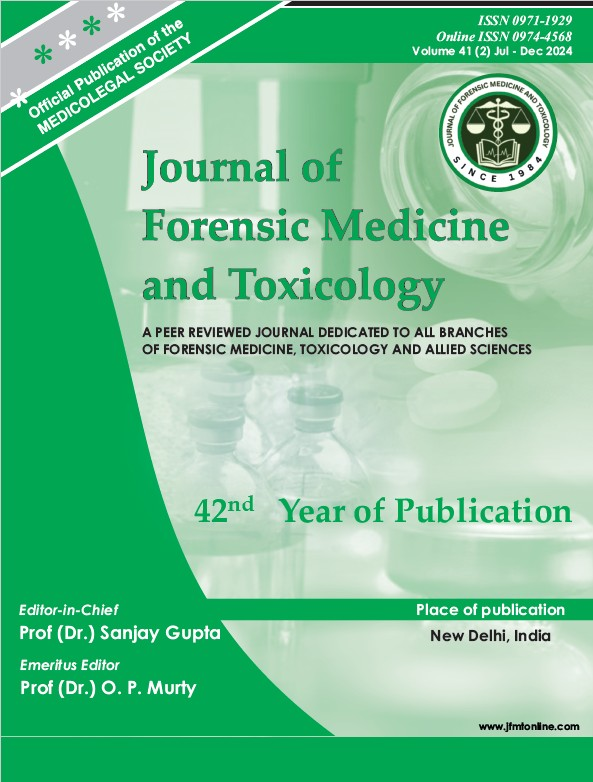A FATAL RUPTURE OF A CEREBRAL ANEURYSM IN A ROAD TRAFFIC ACCIDENT: TRAUMATIC OR SPONTANEOUS!
DOI:
https://doi.org/10.48165/jfmt.2024.41.1.25Keywords:
Aneurysm, Forensic pathology, Posterior communicating artery, Road traffic accident, Rupture, Subarachnoid haemorrhageAbstract
An aneurysm is an abnormal dilatation or bulging in a blood vessel due to the intrinsic weakness of the vessel wall. Cerebral aneurysms are more common over the age of 40, with a female-to-male ratio of 2:1. We report a case of a 56-year-old female rear passenger of a motorised two-wheeler with an alleged history of dizziness and fall from the bike. Following this, she had altered sensorium and loss of consciousness and presented to the casualty with a Glasgow coma scale (GCS) score of 10. On examination, the left pupil was not reacting to light; left eye proptosis and drooping of the eyelid were present. Radiological investigations diagnosed it as a left posterior communicating artery (PCOM) ruptured saccular aneurysm. Clipping of the left posterior communicating artery aneurysm was done. Later, the patient’s health deteriorated, and she died. On autopsy, diffuse subarachnoid haemorrhages were present over the basal region, and bilateral intraventricular haemorrhage was present. The base of the brain showed aneurysmal clipping at the PCOM artery. In this case report, we discuss the challenging aspects of finding the relationship between trauma and rupture of cerebral aneurysm.
Downloads
References
D’Souza S. Aneurysmal Subarachnoid Hemorrhage. J Neurosurg Anesthesiol. 2015;27(3):222–240. https:// doi.org/10.1097/ANA.0000000000000130
Faluk M, De Jesus O. Saccular Aneurysm. In: StatPearls [Internet]. Treasure Island (FL): StatPearls Publishing; 2022. Available from: https:// www.ncbi.nlm.nih.gov/books/NBK557867/
Drake CG, Peerless SJ. Giant fusiform intracranial aneurysms: review of 120 patients treated surgically from 1965-1992. J Neurosurg. 1997;87:141–162. https:/ /doi.org/10.1097/ANA.0000000000000130
Keedy A. An overview of intracranial aneurysms. Mcgill J Med. 2006;9(2):141-6. https://doi.org/10.26443/ mjm.v9i2.672
Jersey AM, Foster DM. Cerebral Aneurysm. In: StatPearls [Internet]. Treasure Island (FL): StatPearls Publishing; 2023. Available from: https:// www.ncbi.nlm.nih.gov/books/NBK507902/
Vernooij MW, Ikram MA, Tanghe HL, Vincent AP, Hofman A, Krestin GP, et al. Incidental findings on brain MRI in the general population. N Engl J Med. 2007;357:1821–1828. https://doi.org/10.1056/
NEJMoa070972
Skowronek R, Kobek M, Jankowski Z, Paj¹k EZ, Pa³asz A, Kowalczyk JP, et al. Traumatic basal subarachnoid haemorrhage or ruptured brain aneurysm in 16-year-old boy? - case report. Arch Med Sadowej Kryminol. 2016;66(1):32–40. https://doi.org/ 10.5114/amsik.2016.62333
Priebe HJ. Aneurysmal subarachnoid haemorrhage and the anaesthetist. Br J Anaesth. 2007;99(1):102– 118. https://doi.org/10.1093/bja/aem119
Ogungbo B, Gregson B, Blackburn A, Barnes J, Vivar R, Sengupta R, et al. Aneurysmal subarachnoid hemorrhage in young adults. J Neurosurg. 2003;98:43– 9. https://doi.org/10.3171/jns.2003.98.1.0043
Cairns CJ, Finfer SR, Harrington TJ, Cook R. Papaverine angioplasty to treat cerebral vasospasm following traumatic subarachnoid haemorrhage. Anaesth Intensive Care 2003;31:87–91. https://doi.org/ 10.1177/0310057X0303100117
Cummings TJ, Johnson RR, Diaz FG, Michael DB. The relationship of blunt head trauma, subarachnoid hemorrhage, and rupture of pre-existing intracranial saccular aneurysms. Neurol Res. 2000;22(2):165-70. https://doi.org/10.1080/01616412.2000.11741055
Hsieh CT, Lin EY, Tsai TH, Chiang YH, Ju DT. Delayed rupture of pre-existing cerebral aneurysm in a young patient with minor head trauma. J Clin Neurosci. 2007;14(11):1120-2. https://doi.org/10.1016/ j.jocn.2006.03.014
Okawara SH. Warning signs prior to rupture of an intracranial aneurysm. J Neurosurg. 1973;38:575- 580. https://doi.org/10.3171/jns.1973.38.5.0575
Steinmann J, Hartung B, Bostelmann R, Kaschner M, Husien MB, Karadag C, et al. Intracerebral aneurysm rupture due to head trauma. Forensic Sci. Int. Rep. 2020;2:100123. https://doi.org/10.1016/ j.fsir.2020.100123




